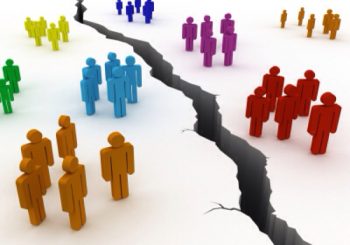 By Estee Horn
By Estee Horn
Guest Writer for Wake Up World
“Don’t believe every thing you think.” – Byron Katie
Are you realistic?
We all want to be objective, to comprehend life accurately, make the most out of it, and always be composed, profound and enlightened. Yet, our emotions and misperceptions constantly attempt to get in our way and mess everything up. Our affection for our loved ones pleasantly blinds us, while our dislike of the people in the groups we despise blinds us much more. We keep ourselves from being as blind as other people, obviously, but we’re still not as unprejudiced as we wish ourselves to be.
[pro_ad_display_adzone id=”110028″]
We can’t help being emotional every now and then, though we know our irrationality damages our society and our lives. Yet, we can find out how our biases work, and how to avoid our idiocy as much as we can.
Because by understanding ourselves better, we can become wiser, better, people.
Yes. We can.
How Groups Are Made Up
Groups are created when people decide to distinguish some individuals, and draw imaginary lines to separate them from the others. These made-up dividers may be based on physical criteria like skin hues, on behaviors like sex partnerships, on beliefs, origins, or any other whims. However, whether the grouping is done by people in or out of the group, it’s always based on a narrow perception. It can never address the entire complicated character people regrettably have.
It’s much easier to judge a person by a specific criterion and not by knowing them deeply, which is what makes grouping so popular. Yet, focusing on one bunch of qualities and ignoring the whole picture demands ignorance of reality. Ignoring reality is something we, mankind, are so good at that we use to forget it’s still there. But reality is always there.
Countries, for example, draw lines on maps, and set imaginary borders. Even if these borders are marked with real fences, they’re still imaginary; they don’t exist in reality, only in peoples’ heads.
The people on one side of this imaginary line may differ from the people on the other side by their culture and origin, and every side may be sure that they’re much superior to the others, but actually they can’t be utterly different. Truly, the differentiation is imaginary.
Within their imaginary borders, countries inflict their imaginary laws. As long as enough people accept these borders and laws and imagine them together, they have real implications.
Why Our Myths Are Not Reliable
Yuval Noah Harari explains in Sapiens: A Brief History of Humankind, that “Any large-scale human cooperation…is rooted in common myths that exist only in people’s collective imagination.”
People are able to create very complex social, economical and political imaginary systems. Like children’s make-believe worlds, our systems can have rules and physical punishments. These made-up systems can also have imaginary currencies we exchange for concrete goods.
Yet, like children’s worlds, these imaginary systems can work only as long as enough people cooperate with them. Otherwise they collapse.
Fortunately.
We see it all the time, for example, when our currencies rise and fall only according to people’s changing trust in them. As our money no longer represents anything in reality, its value is determined just by people’s cooperation. Grasping the nature of money as nothing but a collective imagination, lets us understand why the national money is essentially no different than digital currencies, LETSystems units, or Time Banking. The type of currency doesn’t matter, the collaboration of people is the only thing that matters.
Why We Better See Through The Myth
Recognizing that our insecure lives are based on so much imaginary, shaky complexes, can indeed be startling. As Aldous Huxley wrote, “You shall know the truth, and the truth shall make you mad.” Nevertheless, we better see reality as it is. Realism tends to be both safer and more powerful.
We can still collaborate with our imaginary countries, currencies, companies, and other made-up complexes that don’t even have to start with a C. Yet, we better understand their imaginary nature.
It can help us use them better.
It can help us avoid their problems better.
It can help us change them better.
It helps us understand, for example, how ridiculous is the idea that people who happen to live on one side of an imaginary line are all in favor of you, while people who happen to live on the other side are all against you.
Generally, understanding the mythical nature of groups helps us see how fragile the made-up lines between them are.
How temporary these imaginary lines are.
How absurd it is to think we can know anything about anyone just because of their association with some imaginary groups.
The Freedom Of Reality
Learning to see reality as it is can be very liberating.
It frees us to see that, essentially, there are no “us” and “them”, as no alienating divider is real.
In reality, every grouping of people is imaginary. Every group is nothing but various individuals, who are part of the ultimate “us”.
Truly, we’re all the same: people who imagine together.
We’re living the life we imagine, and we can change our shared images. Seeing reality frees us to choose which society we want to imagine together.
Would it be the current one?
Would it be a better one?
Would it be, for instance, John Lennon’s “Imagine all the people sharing all the world…all the people living life in peace”?
We can create kinder, more realistic images, of others and of ourselves.
It’s up to each one of us.
By accepting the people of one “group” at a time.
By accepting one individual at a time.
Starting now.
Recommended Articles by Estee Horn:
- What Tricks You Into Eating Too Much – And How To Beat Your Hunger-Imposters
- How the World’s Changeover Can Superbly Change Your Life
- The (Bright New) Day After Tomorrow
- How Coronavirus Sends Us All to Our Rooms to Think About What We’ve Done
- Struggling With Your Goals? Releasing Your Unconscious Addictions Can Free You to Achieve
About the author:
 Author Estee Horn comes from a long line of not-so-warty healing women. She uses their word-craft, as well as her MA in Eco-Psychology, to help people slow life down and be happier. Get her free life-changing blueprint of Creating The Life You Want.
Author Estee Horn comes from a long line of not-so-warty healing women. She uses their word-craft, as well as her MA in Eco-Psychology, to help people slow life down and be happier. Get her free life-changing blueprint of Creating The Life You Want.
[pro_ad_display_adzone id=”110027″]






